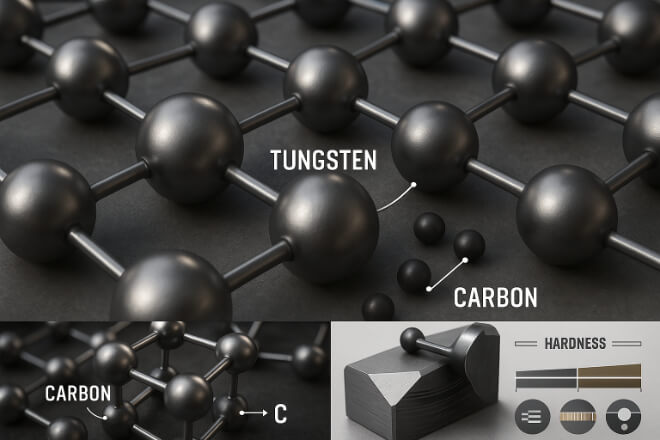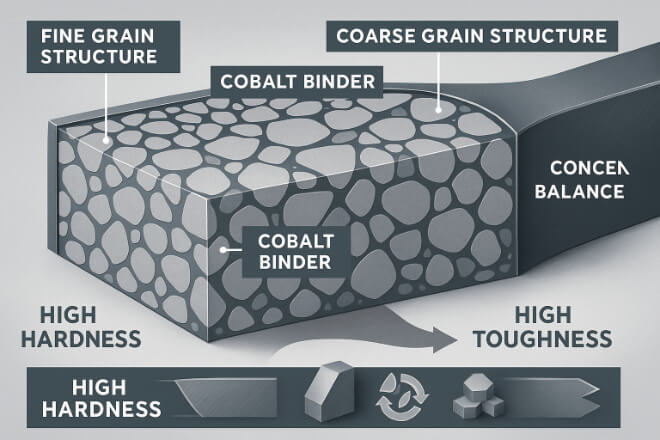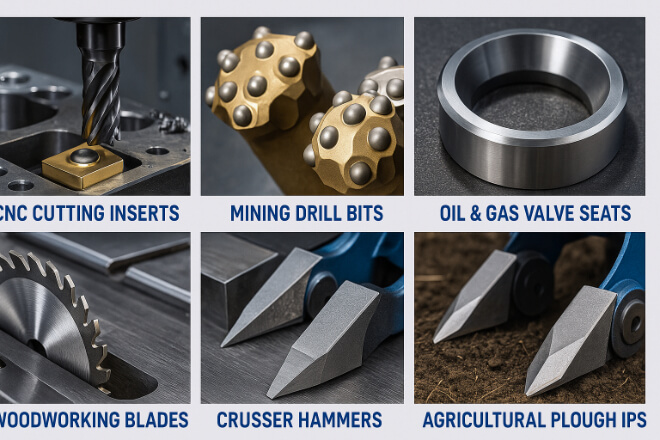Le carbure de tungstène est l’un des matériaux les plus importants dans la fabrication moderne.
Connu pour son caractère exceptionnel dureté, dureté, et résistance à l'usure, il est utilisé dans outils de coupe, équipements miniers, pièces d'usure et de nombreuses applications industrielles.
Mais derrière ces propriétés impressionnantes se cache la science de la métallurgie, l’étude de la manière dont les métaux et les alliages sont conçus, traités et optimisés.
Comprendre la métallurgie du carbure de tungstène aide les décideurs à sélectionner la nuance adaptée à des applications spécifiques, à améliorer la durée de vie des outils et à réduire les coûts.
Cet article explique la composition, la structure, le processus de fabrication et les facteurs de performance qui rendent le carbure de tungstène si précieux dans l’industrie.
Qu'est-ce que le carbure de tungstène ?

Le carbure de tungstène est un composé de tungstène (W) et de carbone (C). Sa formule est WC, ce qui signifie que chaque molécule contient un atome de tungstène et un atome de carbone.
Le tungstène fournit dureté et la densité.
Le carbone forme des liaisons chimiques fortes qui rendent le matériau résistant à l’usure.
Dans la plupart des applications industrielles, le carbure de tungstène est cimenté avec un liant métallique tel que le cobalt (Co) ou le nickel (Ni) pour améliorer dureté.
Cette combinaison donne un matériau plus dur que l’acier, mais beaucoup plus résistant que la céramique pure.
Principales propriétés du carbure de tungstène
Le carbure de tungstène est unique car il combine des propriétés qui sont généralement opposées dans d’autres matériaux.
| Propriété | Valeur typique | Importance dans l'industrie |
|---|---|---|
| Dureté (HV) | 1400–2400 | Résiste à l'usure et à l'abrasion |
| Densité | 14–15 g/cm³ | Assure la stabilité des outils |
| Point de fusion | ~2 870 °C (5 198 °F) | Résistance aux hautes températures |
| Résistance à la compression | 4000 MPa+ | Supporte des charges extrêmes |
| Dureté | Dépend de la teneur en liant | Résiste aux fissures et à l'écaillage |
Le rôle de la métallurgie dans le carbure de tungstène

La métallurgie ne se limite pas à mélanger le tungstène et le carbone. Elle implique de contrôler la granulométrie, la teneur en liant et la distribution afin d'obtenir l'équilibre souhaité entre dureté et la ténacité.
Granulométrie : Les grains fins augmentent la dureté mais la réduisent dureté; les grains grossiers améliorent la ténacité mais diminuent la dureté.
Teneur en liant : une teneur plus élevée en cobalt augmente la ténacité mais peut diminuer la dureté.
Additifs : De petites quantités d’autres carbures (comme le carbure de titane, TaC) peuvent améliorer la résistance à la chaleur ou réduire la croissance des grains.
Fabrication du carbure de tungstène : le procédé de métallurgie des poudres

Le carbure de tungstène est fabriqué par métallurgie des poudres, ce qui permet un contrôle précis de ses propriétés.
Processus étape par étape :
Préparation de la poudre – Les poudres de tungstène et de carbone sont mesurées et mélangées.
Carburation – Le mélange est chauffé pour former des particules de WC.
Ajout de liant – De la poudre de cobalt ou de nickel est ajoutée au mélange.
Mélange et broyage – Assure une répartition uniforme des grains de carbure et du liant.
Pressage – Le mélange est pressé pour obtenir la forme souhaitée.
Frittage – La pièce pressée est chauffée jusqu’à un point proche du point de fusion pour lier les particules entre elles.
Finition – Meulage, revêtement ou polissage pour répondre aux exigences dimensionnelles.
Contrôle de la dureté et de la ténacité
La métallurgie du carbure de tungstène se concentre sur l’équilibre entre la dureté et la ténacité pour répondre aux besoins de l’application.
Haut Dureté Nuances – Idéal pour la coupe de matériaux durs (grain fin, faible teneur en liant).
Haut Dureté Nuances – Idéal pour les charges d’impact ou de choc (gros grain, liant élevé).
Grades équilibrés – Utilisés dans les pièces d’usure à usage général.
Guide de sélection des notes
| Type de note | Niveau de dureté | Niveau de ténacité | Meilleures applications |
|---|---|---|---|
| Grain fin, faible teneur en liant | Haut | Faible | Outils de coupe de précision |
| Grain moyen, liant moyen | Moyen | Moyen | Pièces d'usure générales |
| Gros grains, liant élevé | Inférieur | Haut | Outils miniers, pièces résistantes aux chocs |
Applications industrielles du carbure de tungstène

La polyvalence du carbure de tungstène provient de sa métallurgie réglable.
Outil de coupe de métals – Fraises, forets, plaquettes.
Exploitation minière et perçage – Boutons, pointes et plaques d’usure.
Pétrole et gaz – Sièges de soupapes, buses, outils de fond.
Travail du bois – Lames de rabot, pointes de scie.
Agriculture – Lames de charrue, pièces travaillant le sol.
L'avenir de la métallurgie du carbure de tungstène

La recherche repousse les limites avec :
Carbure de tungstène nano-grain pour une meilleure dureté sans perdre en ténacité.
Revêtements avancés (TiAlN, DLC) pour améliorer la résistance à la chaleur et résistance à l'usure.
Procédés de recyclage pour récupérer le tungstène et le cobalt des outils usés.
Ces innovations permettent aux pièces en carbure de durer plus longtemps, d’être plus performantes et plus durables.
Conclusion
La métallurgie du carbure de tungstène est la clé de son succès dans les applications industrielles.
En contrôlant la granulométrie, la teneur en liant et les additifs, les fabricants créent des matériaux avec le bon équilibre entre dureté et ténacité pour chaque travail.
Pour les décideurs, comprendre ces facteurs signifie faire de meilleurs choix qui améliorent les performances, prolongent la durée de vie des outils et réduisent les temps d’arrêt.
Si vous souhaitez en savoir plus sur une entreprise, n'hésitez pas à Contactez-nous.
